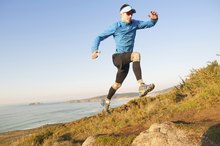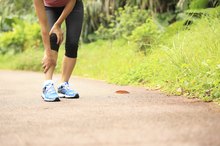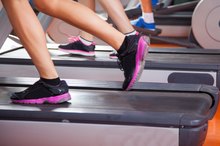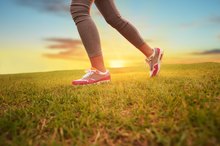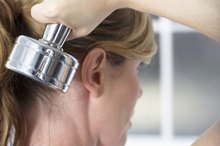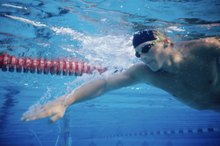Causes of Calf Pain During Jumping Jacks
Jumping jacks are a traditional method of aerobic exercise that helps you burn calories. However, if you experience pain in your calves -- the muscles on the back of your lower legs -- while performing this exercise, you might be experiencing symptoms of one of numerous possible conditions.
If you are experiencing serious medical symptoms, seek emergency treatment immediately.
Jumping Jacks
Begin this exercise by standing straight with your legs together and arms at your sides. Jump into the air while simultaneously raising your arms above your head, clapping your hands and landing with your feet spread apart. To return to the starting position, jump your legs back together; and return your arms to your sides. This exercise is performed fairly quickly for someone who is physically fit and at a lesser speed if you're just beginning a fitness regimen.
- Begin this exercise by standing straight with your legs together and arms at your sides.
- Jump into the air while simultaneously raising your arms above your head, clapping your hands and landing with your feet spread apart.
Tennis Leg
Pain in the Quadriceps
Learn More
Tennis leg is a torn gastrocnemius or plantaris -- two major muscles of the back lower leg. A jumping movement may cause this injury, and standing on your tip-toes can especially cause pain or weakness. Talk to your health care provider for possible treatment, which might include cold therapy, elevation of the foot or resting the affected muscles.
Achilles Tendonitis
If your lower leg pain is localized between your lower calf and your heel, you may be experiencing Achilles tendinitis. This condition occurs from the overuse of the Achilles tendon and pain can be worsened during jumping activities. Your health care provider may suggest nonsteroidal anti-inflammatory drugs, such as ibuprofen, to reduce pain and swelling, as well as resting your calf and ice therapy.
Gastrocnemius Strain
Running & Collarbone Pain
Learn More
The largest of your calf muscles is the gastrocnemius. When this muscle is strained -- often referred to as a pulled calf muscle -- it has a partial tear. Activities that require a lot of running or jumping leave athletes susceptible to this type of injury, particularly if too much stress is put on the muscle in a short period. Symptoms of a gastrocnemius strain include pain, stiffness and weakness in the muscle. Common treatments for this injury include cold therapy, elevation, over-the-counter pain medications and rest of the muscle until the partial tear is healed.
- The largest of your calf muscles is the gastrocnemius.
- Common treatments for this injury include cold therapy, elevation, over-the-counter pain medications and rest of the muscle until the partial tear is healed.
Warning
Deep vein thrombosis, also referred to as DVT, is a more serious health condition that is often characterized by pain in the calf muscles 1. While pain from many muscular injuries are more pronounced during certain activities, such as jumping, a DVT may cause pain in the calf muscles at any given time. These potentially dangerous blood clots tend to form in large veins of the legs, causing pain and swelling in the calf muscles, along with a possible warm, discolored area of the skin. Because of the potential health risks of DVT -- pulmonary embolisms and death -- this condition requires immediate medical attention.
- Deep vein thrombosis, also referred to as DVT, is a more serious health condition that is often characterized by pain in the calf muscles 1.
- These potentially dangerous blood clots tend to form in large veins of the legs, causing pain and swelling in the calf muscles, along with a possible warm, discolored area of the skin.
Related Articles
References
- University of Maryland Medical Center: Deep Vein Thrombosis
- Leow KS, Chew KM, Chawla A, Lim TC. Sonographic assessment of musculoskeletal causes of calf pain and swelling. Emerg Radiol. 2019;26(3):349-359. doi:10.1007/s10140-019-01680-5
- Green B, Pizzari T. Calf muscle strain injuries in sport: a systematic review of risk factors for injury. Br J Sports Med. 2017;51(16):1189-1194. doi:10.1136/bjsports-2016-097177
- Grassi A, Quaglia A, Canata GL, Zaffagnini S. An update on the grading of muscle injuries: a narrative review from clinical to comprehensive systems. Joints. 2016;4(1):39–46. doi:10.11138/jts/2016.4.1.039
- Harwin JR, Richardson ML. "Tennis leg": gastrocnemius injury is a far more common cause than plantaris rupture. Radiol Case Rep. 2016;12(1):120–123. doi:10.1016/j.radcr.2016.10.012
- Hotfiel T, Seil R, Bily W, et al. Nonoperative treatment of muscle injuries - recommendations from the GOTS expert meeting. J Exp Orthop. 2018;5(1):24. doi:10.1186/s40634-018-0139-3
- Avruskin A. Physical therapy guide to calf strain. American Physical Therapy Association. Updated October 17, 2019.
- Kary JM. Diagnosis and management of quadriceps strains and contusions. Curr Rev Musculoskelet Med. 2010;3(1-4):26-31. doi:10.1007/s12178-010-9064-5
- Wilbur J, Shian, B. Diagnosis of deep venous thrombosis and pulmonary embolism. Am Fam Physician. 2012 Nov 15;86(10):913-19.
- Frush TJ, Noyes FR. Baker's cyst: Diagnostic and surgical considerations. Sports Health. 2015;7(4):359-65. doi:10.1177/1941738113520130
- Boyd RP, Dimock R, Solan MC, Porter E. Achilles tendon rupture: how to avoid missing the diagnosis. Br J Gen Pract. 2015;65(641):668-9. doi:10.3399/bjgp15X688069
